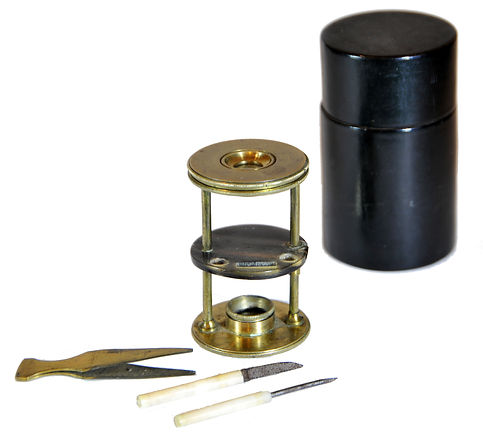

Withering-type botanical microscope, 1780
The “Withering-type Microscope” is named for its inventor, Dr. William Withering (1741-1799), an English physician and botanist who graduated with a degree in medicine 1766 in Edinburgh. Inspired by the taxonomical work and systematic classification of Carl Linnæus (1707-1778), Withering (1776) applied the Linnaean taxonomical system of classification to British plants in a seminal, two volume work, A Botanical arrangement of all the vegetables naturally growing in the British Isles. The earliest reference to a small botanical microscope of Withering’s design appeared in the first edition of this book. There, Withering indicated this microscope was developed for field dissections of flowers and other plant parts. While there is no surviving example of this exact design, close relatives of this type do exist, made either completely of brass or of ivory with brass pillars. Ivory models can be tentatively dated to 1776-1785, as by 1787 a newer model with a hollowed stage in an all-brass configuration already predominated. In turn, it was preceded by the brief appearance of a transitional brass model but with solid stage of ivory or horn (seen here). This version is extremely rare and must have been produced in very small numbers. By 1787 all these varieties were not recorded anymore in the literature.

Withering-type botanical microscope, 1780
The “Withering-type Microscope” is named for its inventor, Dr. William Withering (1741-1799), an English physician and botanist who graduated with a degree in medicine 1766 in Edinburgh. Inspired by the taxonomical work and systematic classification of Carl Linnæus (1707-1778), Withering (1776) applied the Linnaean taxonomical system of classification to British plants in a seminal, two volume work, A Botanical arrangement of all the vegetables naturally growing in the British Isles. The earliest reference to a small botanical microscope of Withering’s design appeared in the first edition of this book. There, Withering indicated this microscope was developed for field dissections of flowers and other plant parts. While there is no surviving example of this exact design, close relatives of this type do exist, made either completely of brass or of ivory with brass pillars. Ivory models can be tentatively dated to 1776-1785, as by 1787 a newer model with a hollowed stage in an all-brass configuration already predominated. In turn, it was preceded by the brief appearance of a transitional brass model but with solid stage of ivory or horn (seen here). This version is extremely rare and must have been produced in very small numbers. By 1787 all these varieties were not recorded anymore in the literature.
References: SML: A242712; Goren 2014.
References: SML: A242712; Goren 2014.
Prof. Yuval Goren's Collection of the History of the Microscope
Early 19th Century Dissecting Microscopes

© Microscope History all rights reserved
Inv. YG-14-003

© Microscope History all rights reserved
Raspail Chemical Microscope, 1835
Initially, based on the aquatic microscope design of the second half of the 18th century, the microscope is mounted on a mahogany box with a drawer and supports a horizontally adjusting eyepiece, rackwork adjusted swing-arm stage, and a pivoting mirror; the drawer holds two additional eyepieces and a dissecting set of tools. This microscope was produced by the Parisian optician Louis Joseph Deleuil (1795-1862), according to specifications suggested by François-Vincent Raspail (1794–1878), as a modified version of the Cuff/Ellis type aquatic microscope. In the literature, it is said to have tourmaline lenses for high magnifications (to reduce aberrations as tourmaline has an extremely high refractive index). Still, my examination of at least the high magnification in this instrument proved it untrue.
This successful design of a portable single microscope was planned by François-Vincent Raspail (1794–1878, picture below with his microscope), a political reformer and activist and a prominent early 19th-century scientist. Raspail (seen in the photo with this type of microscope) was a founder of microscopical methods in chemistry, a pioneer of organic chemistry and one of the first founders of the cell theory in biology. Raspail also pioneered the staining methods in cell biology using iodine to highlight their different parts. As a politician, Raspail was a devoted republican who was active during the restless periods of the First Empire, the Restoration, the Second Republic and the Second Empire, for which he was sentenced several times to prison.
References: SML: 1921-247; Nuttall 1979: 52; Golub: 235; Harvard: 1302, 1905, 1022, 1990-2-0005, 1094; Wissner; Kuhn; Sobel Coll; Balasse; Harvard Univ. 1302, 1095, 1022; Coffeen 2013: 17; Molecular Expressions.

François-Vincent Raspail and his microscope
Hartnack and Oberhauser, Raspail-Type Microscope, 1857-60
This is a later version of Raspail's dissecting microscope, made by George Oberhauser and Edmund Hartnack in Paris.
Edmund Hartnack (1826-91) was a highly esteemed Prussian microscope maker. In 1842-1847 he apprenticed in Berlin under the mechanic Wilhelm Hirschmann senior (1777-1847), which in turn worked with Schiek and Pistor. In 1847 Hartnack moved to Paris to join Heinrich Daniel Rühmkorff (1803-1877), but later he joined the instrument-making firm of Georges Oberhäuser. As opposed to a widespread error probably first introduced by Brian Bracegirdle, Oberhäuser was not Hartnack's uncle! In 1854 Oberhäuser and Hartnack formed a partnership after the latter married Johanna Maria Louise Kleinod, Oberhäuser's niece. In 1864 Hartnack took over the business, from which his former boss had withdrawn more and more. Hartnack established his workshop at 21 Place Dauphin in Paris in 1860. In 1864 he joined forces with the Polish astronomer and mathematician Adam Prazmowski, the former assistant to the Warsaw Observatory and participant in various expeditions to observe solar eclipses and to measure degrees. Prazmowski escaped The January Uprising in Poland and became the production manager of the Hartnack firm. Hartnack had to leave Paris during the French-Prussian War of 1870 and maintained his factory in Potsdam, leaving his partner Prazmowski, in Paris. In 1878, Prazmowski became the owner of the Parisian branch. After his death in 1885, the master Bézu & Hausser took over the workshop and sold it to Alfred Nachet in 1896.


Inv. YG-22-031
© Microscope History all rights reserved